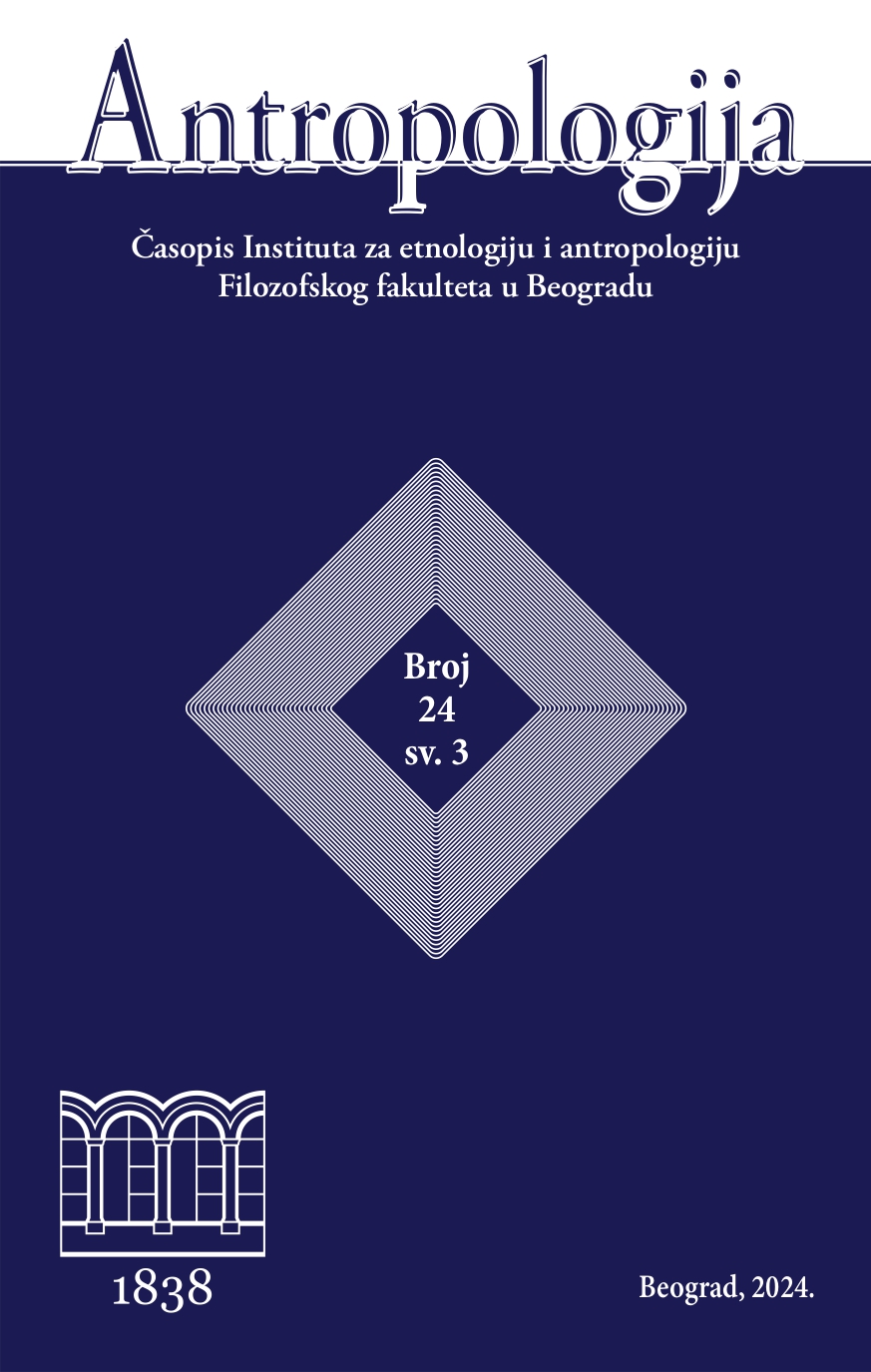From an End to the End: The Fourth Age in the Movie Amour
Keywords:
fourth age, old age, the body, movie, anthropologyAbstract
The paper aims to relate the movie narrative of a highly acclaimed film Amour (2012) by Michael Haneke and the concept of the fourth age which is constructed in relation to the third age concept, understood as its antithesis in the 20th century. The film illustrates a rapid and irreversible transformation of a retired piano teacher, who shifts from being an active and successful elderly person in control of her life plans to facing a sudden health crisis. This deterioration forces her into dependence on others for care, leaving her as a fourth-ager with little to no agency over her own life and its ending. Her reliance on her husband, coupled with his acceptance of responsibility, acts as a buffer against societal strategies for managing the rising elderly population. This relationship also forms the basis for analyzing the coping strategies available to those experiencing rapid health decline, as well as to those observing the suffering of their loved ones. The three-level analysis of the production, content and reception as an established methodological procedure attributable to anthropology of movie will serve as a path to the diegesis aimed at a better understanding of the issues marked in contemporary society.
References
Adiseshiah, Siân. 2023. Old Age, Gender and Constructions of the Contemporary. Journal of the British Academy 11(s2), 33–54. https://doi.org/10.5871/jba/011s2.033
Baltes, Paul B. and Jacqui Smith. 2003. New Frontiers in the Future of Aging: From Successful Aging of the Young Old to the Dilemmas of the Fourth Age. Gerontology 49:123–135 DOI: 10.1159/000067946
Chivers, Sally. 2011. The Silvering Screen. Old Age and Disability in Cinema. Toronto: University of Toronto Press. Encyclopedia of Gerontology and Population Aging, edited by Danan Gu and Matthew E. Dupre Editors, 765–769. Cham: Springer Nature Switzerland AG.
Chivers, Sally and Ulla Kriebernegg. 2021. „Care Home Stories”. In Encyclopedia of Gerontology and Population Aging, edited by Danan Gu and Matthew E. Dupre Editors, 765–769. Cham: Springer Nature Switzerland AG.
Cole, Thomas R. and Ben Saxton. 2017. No Country for Old Men: Four Challenges for Men Facing the Forrth Age. Perspectives in Biology and Medicine 60 (4): 607–614. DOI:https://doi.org/10.1353/pbm.2017.0046
Csordas, Thomas J. 2009. „Telo”. U Enciklopedija društvenih nauka, ur. Adam Kuper i Džesika Kuper, 1418–1419. Beograd: Službeni glasnik.
Dolan, Josephine. 2017. Contemporary Cinema and ‘Old Age’. London: Palgrave Macmillan.
Falcus, Sarah and Stefanie El Madawi. 2021. „Decline and Progress Narrative”. In Encyclopedia of Gerontology and Population Aging, edited by Danan Gu and Matthew E. Dupre Editors, 1322– 1324. Cham: Springer Nature Switzerland AG.
Gilleard, Chris and P. Higgs. 2010. Aging without agency: Theorizing the fourth age. Aging & Mental Health 14(2): 121–128. DOI: 10.1080/13607860903228762
Gilleard, Chris and P. Higgs. 2011. Ageing abjection and embodiment in the fourth age. Journal of Aging Studies 25: 135–142. doi:10.1016/j.jaging.2010.08.018
Gilleard, Chris and P. Higgs. 2013. The fourth age and the concept of a ‘social imaginary’: A theoretical excursus. Journal of Aging Studies 27(4): 368–376.
Higgs, Paul and Chris Gilleard Chris. 2014. Frailty, abjection and the ‘othering’ of the fourth age. Health Sociology Review 23(1): 10–19. https://doi.org/10.5172/hesr.2014.23.1.10
Hirdman Künstlicher, Annika. 2017. Life’s frailty – on fundamentalistic bonds in Haneke’s film Amour, The Scandinavian Psychoanalytic Review 40(1): 63–68. DOI:10.1080/01062301.2017.1374658
Knežić, Branislava. 2006. Samoubistvo starih – (Ne)voljno napuštanje života. Sociološki pregled XXXX (2): 283–295. https://doi.org/10.5937/socpreg0602283K
Kovačević, Ivan. 2015. „Fudbal i film: Drug pretsednik – centarfor”. Etnoantropološki problemi 10 (3): 743–763. https://doi.org/10.21301/EAP.v10i3.9
Laslett, P. 1989. A fresh map of life. London: Weidenfeld and Nicholson.
Milosavljević, Ljubica. 2014a. Antropologija starosti: domovi: konstruisanje starosti kao društvenog problema kroz organizovano domsko zbrinjavanje – od sirotinjskih do staračkih domova. Beograd: Srpski genealoški centar: Odeljenje za etnologiju i antropologiju Filozofskog fakulteta, Etnološka biblioteka.
Milosavljević, Ljubica. 2014b. Antropologija starosti – penzije: konstruisanje društvenog problema kroz penzije – od prvih penzionera do penzionih fondova. Beograd: Srpski genealoški centar: Odeljenje za etnologiju i antropologiju Filozofskog fakulteta, Etnološka biblioteka.
Milosavljević, Ljubica. 2017. „Dead End: Antropološka Analiza Filma ‚Bez stepenika’”. Etnoantropološki problemi 12 (4):1063–1090. https://doi.org/10.21301/eap.v12i4.4.
Milosavljević, Ljubica. 2022. „U njenim godinama: antropološka analiza konstrukta starosti u televizijskoj seriji ‚Kaljave gume’”. Etnoantropološki problemi 17 (2):523–560. https://doi.org/10.21301/eap.v17i2.4.
Milosavljević, Ljubica, Banić Grubišić, Ana i Vladimra Ilić. 2024. Unutar i izvan filmskog žanra: Starost na putu. Etnoantropološki problemi 19 (2):335–357. https://doi.org/10.21301/eap.v19i2.1
Milosavljević, Ljubica and Mladen Stajić. 2024. Anthropological Analysis of the Depiction of Deprivation in Old Age In the Case of the Movie Night Boats. Etnoantropološki problemi 19(3) – u štampi.
Minoa, Žorž. 1994. Istorija starosti: od antike do renesanse. Sremski Karlovci; Novi Sad: Izdavačka knjižarnica Zorana Stojanovića.
O’Neill, D. 2015. Geriatric Medicine and Cultural Gerontology. Age Ageing 44 (3): 353–55.
Petković, Rajko. 2018. Michael Haneke i novi austrijski film. Hrvatski filmski ljetopis 93–94: 51–73.
Robson, Melanie. 2016. Complicity, intimacy and distance: reexamining the active viewer in Michael Haneke’s Amour. Studies in European Cinema: 1–15. DOI10.1080/17411548.2016.1261543
Swinnen, A. 2015. „Ageing in film”. In Routledge Handbook of Cultural Gerontology, edited by Twigg, J. & Martin, W, 69–76. London: Routledge.
Vanden Bosch, Jim. 2013. Amour Killing? The Gerontologist 53(3): 518–519. doi:10.1093/geront/gnt027
Žikić, Boja. 2018. Antropologija tela. Beograd: Univerzitet, Filozofskifakultet, Odeljenje za etnologiju i antropologiju, Centar za antropologiju nauke i obrazovanja: Dosije studio, Biblioteka Etnoantropološki problemi, Monografije, knj. 8.
Worley, Taylor. 2016. Losing Touch: A Theology of Death for Michael Haneke’s Amour. Religions 7, 140: 1–20. doi:10.3390/rel7120140




